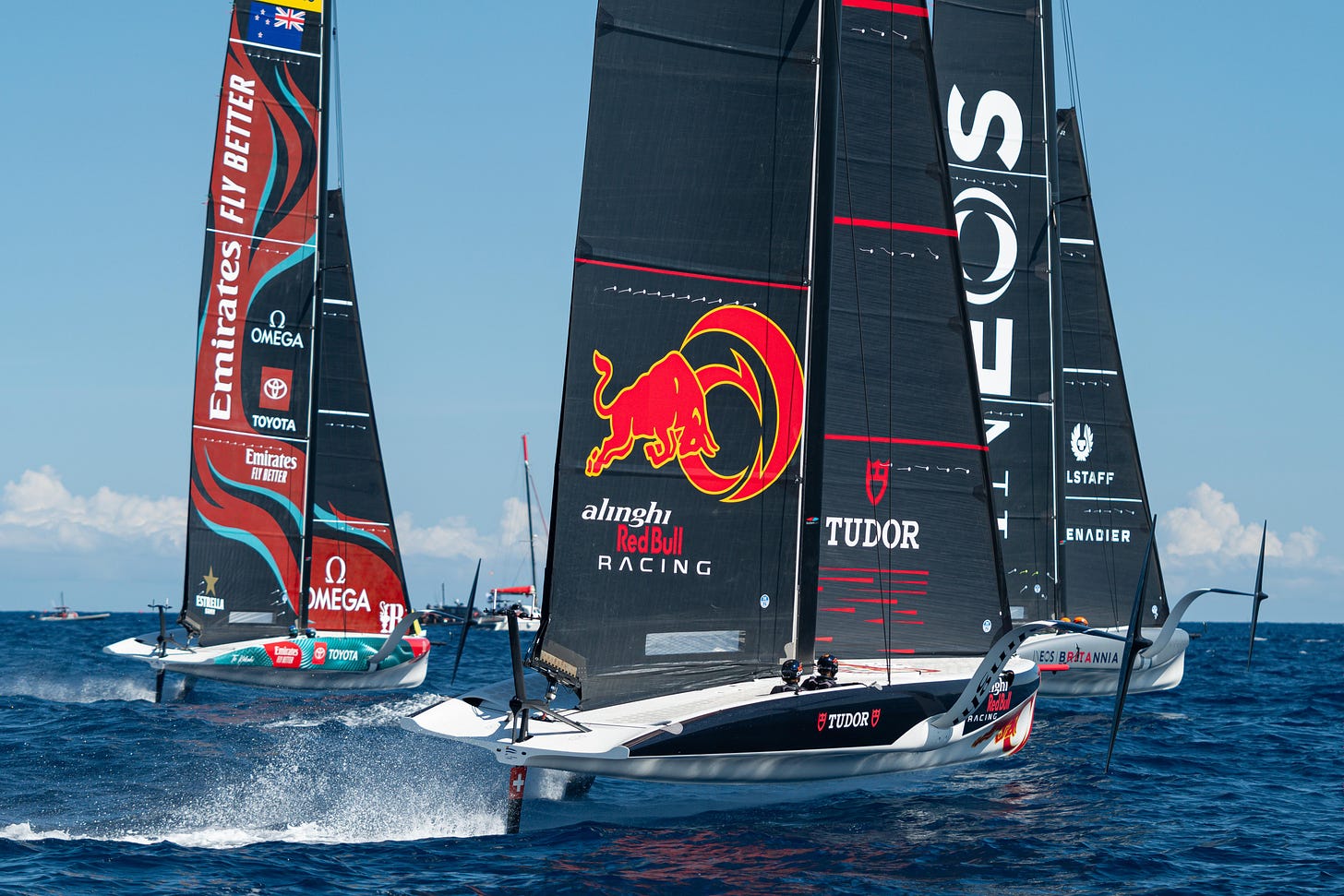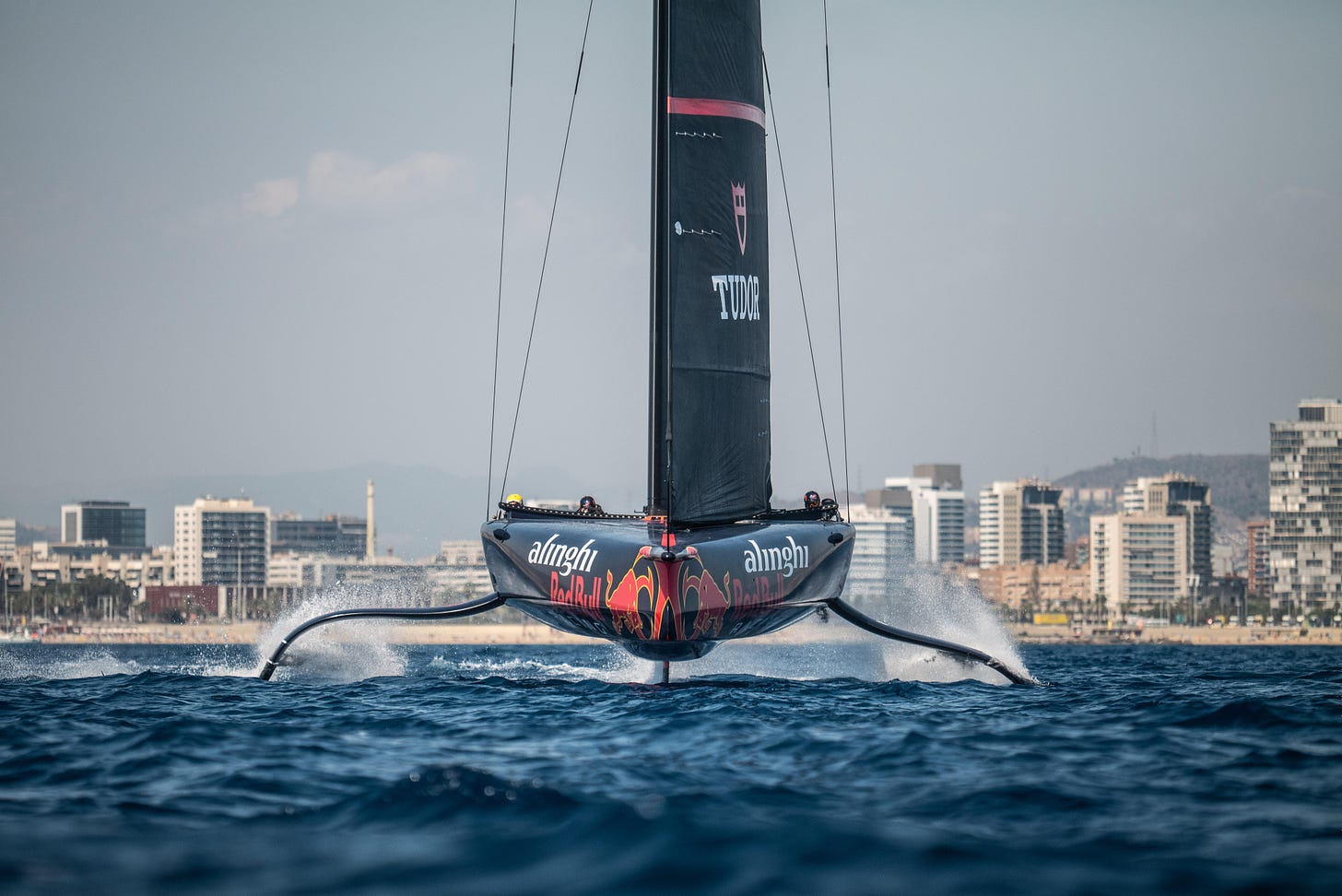America’s Cup Preliminary Regatta – What to expect in Vilanova i La Geltrú
Event details, a form guide, and a bold prediction of the eventual winner – everything you need to know ahead of this week’s opening AC40 event in Spain
There has been a buzz of anticipation around the America’s Cup community here in Barcelona for the past few weeks as the six international teams dotted throughout the city’s Port Vell harbour psyche themselves up for the first official racing of the 37th America’s Cup cycle at the opening regatta of AC37’s three-regatta preliminary series.
This first event – which runs from Wednesday September 13 to Sunday September 17 – is not taking place in the sprawling Catalan capital but rather some 40-plus kilometres south west in the much smaller neighbouring city of Vilanova i La Geltrú and will be raced in identical one design AC40 foiling monohull yachts.
A second AC40 event is scheduled this year in Jeddah, Saudi Arabia from November 29 to December 2, with the final preliminary event – to be raced in the full size custom designed and built AC75 single-hulled foilers – to take place back in Barcelona towards the end of August 2024.
Although the preliminary series does not count for much in relation to the six teams’ main priority – that of either winning or retaining the America’s Cup – it does, in fact, count for something. As specified in Article 7.3 c of the AC37 protocol document the seeding for the first round robin stage of the next year’s Challenger Selection Series will be determined by the final rankings of this three-event series.
Under the protocol all six teams were required to purchase at least one AC40. Three of them – the British INEOS Britannia, the Italian Luna Rossa Prada Pirelli, and the French Orient Express Racing Team – opted for just one boat. Meanwhile, the America’s Cup holders Emirates Team New Zealand (who came up with the AC40 concept in the first place), Switzerland’s Alinghi Red Bull Racing, and the United States syndicate NYYC American Magic, each purchased two boats.
As well as their AC40s, the British and Italian teams designed and built 40-foot prototype test boats (known as LEQ12s for Less or eQual to 12 metres) which they use to validate their design software and to test new foil designs, while the other teams have been allowed to modify one of their AC40s for development purposes – effectively turning it into an LEQ12.
Based on three recent two-day testing / practice events held in Barcelona over recent weeks the form guide going into the opening preliminary regatta in Vilanova i La Geltrú, unsurprisingly, mostly favours the dual AC40 teams.
The Kiwis and the Americans have both looked strong at various times in these events, with the young Swiss crew also proving themselves well capable putting together race winning performances.
Least impressive results–wise in the practice sessions have been the British and French whose relative lack of AC40 time has seen them struggle with boat handling and overall consistency – which, as anyone knows, are the two key factors in any one-design competition.
Then there are the Italians. Despite relentlessly portraying themselves as the underdogs of AC40 fleet, the Luna Rossa Prada Pirelli sailors look anything but that after turning in slick and assured performances in the practice sessions.
So what can America’s Cup fans expect from next week’s Vilanova i La Geltrú regatta?
The format for the preliminary events is predominantly fleet racing with three fleet races per day on Friday and Saturday, two more on Sunday, before the regatta culminates in a one-shot match race between the two top-ranked teams for the regatta. Wednesday and Thursday respectively have been reserved for official training and official practice racing sessions between 1330 and 1730.
On Friday, Saturday and Sunday racing is scheduled to take place in a two hour window between 1530 and 1730 each day with provisional race start times of 1543, 1623, and 1700. (All times are CEST / GMT +2)
Live coverage of all three days of racing will be steamed live on the America’s Cup You Tube channel.
The course format is windward leeward, beginning with an upwind start, with the fleet racing around windward and leeward gates.
Two course lengths can be set: Course 4 being Start, Windward Gate, Leeward Gate, Windward Gate, Finish; and Course 6 being Start, Windward Gate, Leeward Gate, Windward Gate, Leeward Gate, Windward Gate, Finish.
As for all events in AC37 the wind limits for the Vilanova i La Geltrú event are 6.5 to 21 knots with a time limit for the first boat of 10 minutes for the first leg and 30 minutes for each race.
Those America’s Cup fans making the trip to Vilanova in person can take advantage of a free race village with viewing screens or watch from the beach at the nearby Platja de Ribes Roges. On the water spectators will be marshalled into strict viewing zones. There are more details here: https://www.americascup.com/how-to-watch
Given that this is about as pure a one-design regatta as it is possible to organise, the results from this first official racing encounter of the 37th America’s Cup are not going to tell us anything about the complex design battle being waged between the six teams in their quest to conjure up the fastest AC75 ever created.
Nevertheless, this week’s event should be a good indicator of which syndicates have done the best job of gelling their “back four” – the core afterguard of helmsmen and sail trimmers that next year will be responsible for coaxing maximum performance out of the new generation of full size AC75.
It is not a straight comparison, of course, as the flight control element of the AC40 is looked after largely by an autopilot whose parameters – such as the cant angle of the foils, the immersion height of the foils, as well as rudder settings that set the boat’s pitch (bow up/down) angle – are set by the helmsmen.
What will be the same however is how well the members of the afterguard interact and communicate with each other on the racecourse.
There will not be masses of room on the course for six boats each capable of travelling upwards of 40 knots – especially at the start and for the first upwind and downwind legs – and picking a clean path through all that requires perfect coordination between the sailors at all times. The teams that have got closest to that goal are likely to be the ones celebrating on Sunday evening.
But perfect comms and clean lanes will count for nothing if your boat handling lets you down. The AC40s are fast and manoeuvrable and the crews are able to throw them around with apparent ease. But push too hard and these boats will bite back. Every team at some point in training has ‘lost the rudder’ and suffered the instant punishment of a vicious face-planting nosedive that stops the boat dead in its tracks. If you are lucky you can avoid a capsize but your hopes of a decent race result have already evaporated.
Based on what we have seen during the practice racing even a fluffed tack or gybe that ends in the hull touching down will drop you swiftly and unceremoniously to the back of the back of the fleet.
If we are looking for favourites in this opening event then the America’s Cup holders Emirates Team New Zealand must surely be the main candidates. Peter Burling and Nathan Outteridge are a potent pairing on the steering wheels and – although they are far from perfect – in the practice racing we have seen so far (especially when the breeze is up) if they get off the line cleanly they are near impossible to catch.
The Kiwi’s closest challenge is likely to come from American Magic’s British / Australian helming duo Tom Slingsby and Paul Goodison. Both multiple Moth world champions, these once bitter Olympic rivals in the Laser class look to be working in perfect synchronisation in the AC40. After opting out of one two-day practice race block to practice and test alone, they were dominant in last week’s most final session.
Definitely not to be discounted in Vilanova are Luna Rossa Prada Pirelli’s Australian / Italian pairing Jimmy Spithill and Francesco Bruni. Despite the Italians having concentrated primarily on their LEQ12 back at their base in Sardinia, Spithill and Bruni have proved more than capable of taking the fight to the New Zealand and American AC40 crews.
Meanwhile, Alinghi Red Bull Racing’s young Swiss crew have been putting in the hard yards in Barcelona since last year and over recent weeks have been pushing even harder to hone their AC40 technique with help from Kiwi sparring partners Dean Barker and Phil Robertson. The team have announced that primary helmsman Arnaud Psarofaghis will be paired with twenty-five year old Maxime Bachelin with Bryan Mettraux and Yves Detrey as sail trimmers. Nobody should be surprised to see the Swiss take a race win or two in Vilanova i La Geltrú.
Having focussed predominantly on their test boat rather than the AC40 it is perhaps inevitable that the British INEOS Britannia squad have been somewhat lacklustre in the recent test sessions. Illness forced their preferred sail trimming pair Leigh McMillan and Bleddyn Mon out of some of the practice racing, maybe explaining several highly costly boat handling issues. However, with the legendary Ben Ainslie (fresh from a SailGP event victory in St Tropez last weekend) and the imperious Giles Scott partnering up on the wheels we could easily see the British team come out all guns blazing when it matters.
For the French Orient Express Racing Team, who only received their AC40 during August, the Vilanova event is a valuable opportunity to push themselves further up the steep learning curve they find themselves on. Make no mistake, though, the French helming combo Quentin Delapierre and Kevin Peponnet are no slouches when it comes to top flight high performance racing and given a clear lane off the start line in Vilanova i La Geltrú this duo could prove hard to catch.
Taking everything into consideration I am predicting an Emirates Team New Zealand versus American Magic match race final, ahead of the Italians, British, Swiss, and French in that order.
As to who will prevail in the match racing? That’s almost impossible to call based on the sparse evidence we have to work on prior to this opening event. However, put a gun to my head and I will have to pick the Americans – who, I think, at this early stage of this latest America’s Cup cycle have more to prove and will be more fired up for victory.
Will I be proved right or wrong? Use the comments below to let me know what you think. Either way let’s hope for decent breezes and spectacular racing.
Justin












Good summary!